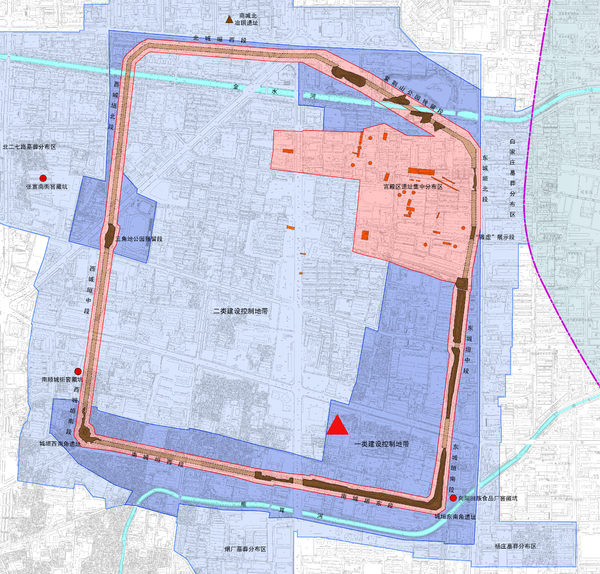Henan's contribution to China's Top 10 New Archaeological Discoveries of 2023①丨Shuyuan Street Cemetery
Henan's contribution to China's Top 10 New Archaeological Discoveries of 2023 Episode I
2023年度全国十大考古新发现中的河南元素①
Shang noble cemetery discovered near Shuyuan Street in Zhengzhou city
郑州商都书院街墓地
The National Cultural Heritage Administration announced its "Top 10 New Archaeological Discoveries of 2023" on March 22, including 2 items from Central China's Henan province, namely the Shuyuan Street Cemetery at the Zhengzhou Shang City Ruins (1600-1046 BC) and the Wangzhuang Ruins (about 3000 BC) located in Yongcheng city.
3月22日,2023年度全国十大考古新发现揭晓,郑州商都书院街墓地、永城王庄遗址入选。

Gold and bronze masks. [Photo provided to dahe.cn]
To facilitate the infrastructure construction in Zhengzhou, an archaeological excavation led by the Zhengzhou Institute of Cultural Relics and Archaeology was carried out in the area bordered by Zijingshan Street, Dongda Street and Shuyuan Street from June 2021 to February 2023, with 15 thousand square meters excavated and 1,710 remains of different dynasties discovered, including the Shang Dynasty (1600-1046 BC), the Waring States Period (475-221 BC), the Han Dynasty (202 BC-220 AD), the Tang Dynasty (618-907), the Song Dynasty (960-1279), the Ming Dynasty (1368-1644) and the Qing Dynasty (1644-1911). Some remains of the Tang and Song are believed to be related to the Kaiyuan Temple built in the Tang Dynasty. The Shang remains, large in number and rich in type, are one of the major discoveries during the excavation, covering a noble cemetery of the Baijiazhuang Period of Shang near Shuyuan Street, ash pits and housing foundations.
2021年6月—2023年2月,为配合郑州市基本建设,郑州市文物考古研究院对郑州市紫荆山路东侧、东大街南侧、书院街北侧区域进行了考古发掘,发掘面积15000平方米。发掘各类遗迹1710处,遗迹年代涵盖商代、战国汉代、唐宋及明清各时期(唐宋时期的部分遗存或与唐代开元寺相关)。本次发掘的重要收获之一即类型丰富、数量众多的商代遗迹,包括书院街白家庄期贵族墓地和灰坑、建筑基址等。
With an existing area of some 10 thousand square meters, this cemetery is located in the southeast of the inner city of the Capital Ruins of Shang in Zhengzhou, about 450 meters away from the east city wall and 200 meters away from the south city wall.
白家庄期贵族墓地地处郑州商城内城东南,距东城墙约450米、南城墙约200米,现存面积约1万平方米。

Shuyuan Street cemetery. [Photo provided to dahe.cn]
It is a high-rank noble cemetery of the Baijiazhuang Period with a clear layout and complete functions. Together with 3 storage pits for bronze wares of the same period, it is of great academic value for studying the rise and fall of the Capital Ruins in Zhengzhou, the relationship between this Ruins and the Xiaoshuangqiao site (both are located in Zhengzhou), the capital construction of the Xia (2070-1600 BC) and Shang, the Shang culture, and the origins of Chinese civilization.
书院街墓地是一处结构清晰、功能完备、具有兆域性质的商代白家庄期高等级贵族墓地。结合先前的三处白家庄期铜器窖藏坑等遗存,该墓地的发掘对研究郑州商城的使用兴废、商代王都与小双桥的关系、夏商城址建制、商文化及“中华文明探源”等均具有重要的学术价值和意义。
The discovery of the trenches enclosing the cemetery helps push the history of the cemetery trenches up to the early Shang Dynasty, which was a groundbreaking for the cemetery layout and noble funeral system in Chinese history. Besides, the excavation not only provides new materials for studying the feature of the noble cemetery near Shuyuan Street, capital construction, and functions and layout of the Capital Ruins of Shang Dynasty in Zhengzhou, but also refreshes the knowledge of the layout in the southeast area of the Ruins.
首先,墓地兆沟的确认将先秦兆沟的历史提前至中商早期,对于中国历史上的兆域制度、贵族丧葬体系而言具有明确的开创性。其次,本次考古发掘,不仅为认识书院街墓地的性质、都城建制、郑州商城功能与布局等提供了新的材料,也大大改变了以往对郑州商城东南区域规划历史布局的认识。

Some cultural relics unearthed from M2 tomb. [Photo provided to dahe.cn]
It is worth noting that 6 sacrificial pits containing dog remains were discovered beneath the M2 tomb, showing the unique sacrificial culture of the Shang Dynasty. Besides, the unearthed burial objects - the combination of bronze wares, gold and jade articles - reflect the funeral customs of the early mid-Shang Dynasty. Gold and bronze masks as well as gold round-shaped objects were unearthed from the early-to-mid Shang tombs for the first time, providing evidence for studying the origins of gold masks found at the Sanxingdui site and the exchanges between the Chinese and Western civilizations.
再次,M2墓葬底部6处殉狗坑开启了商人极具特色的殉狗文化,随葬品形成了中商早期丧葬礼制完备的青铜器、金器、玉器组合,特别是金、铜覆面与金泡等是商代早中期墓葬考古的首次发现,为探讨三星堆黄金面具文化的来源及中西文明交流提供了确切依据。

文案:赵汉青 杨佳欣
海报:胡翰泽
审校:李文竞
